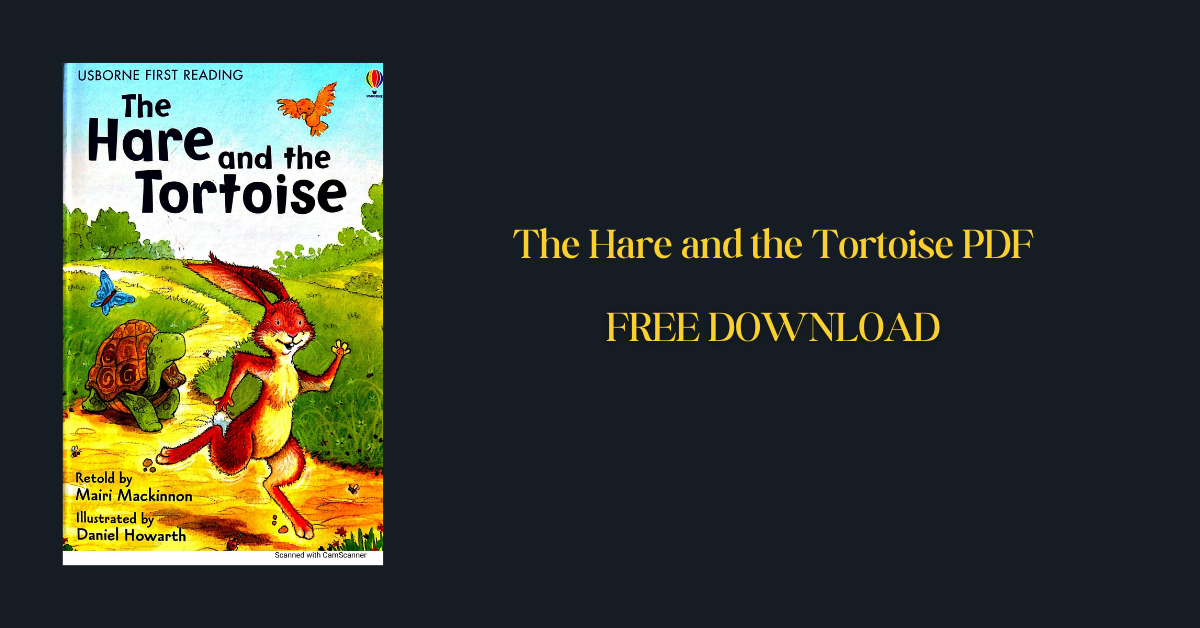“The Hare and the Tortoise” is one of Aesop’s most famous fables, dating back to ancient Greece.
The fable imparts a valuable moral lesson about the importance of perseverance, consistency, and humility. It teaches that overconfidence and arrogance can lead to downfall, while determination and steady progress can ultimately lead to success.
To date, “The Hare and the Tortoise” remains a timeless story with enduring relevance, emphasizing the importance of not underestimating others and the power of persistence in achieving one’s goals.
| Name of the PDF | The Hare and the Tortoise |
| No. of pages | 3 |
| Genre | Comedy, Fiction |
| Language | English |
| Drama PDF | Click Here |
Also Download
Plot Summary of The Hare and The Tortoise
The story begins with the Hare, a swift and confident animal, boasting about its speed and making fun of the Tortoise for being slow. The Tortoise, despite his sluggish nature, remains calm and humble, not reacting to the Hare’s taunts.
One day, the Hare challenges the Tortoise to a race, believing that victory is assured due to his incredible speed. The Tortoise, displaying his determination, accepts the challenge without any arrogance. They agree on a racecourse, and the race begins.
As soon as the race begins, the Hare dashes ahead, quickly leaving the Tortoise far behind. Feeling overly confident in his abilities, the Hare decides to take a nap under a tree, believing that he has plenty of time to win the race. Meanwhile, the Tortoise plods along steadily, never stopping, and always keeping his focus on the finish line.
While the Hare sleeps, the Tortoise continues his slow but unwavering progress. Hours pass, and when the Hare finally wakes up, he is shocked to find the Tortoise near the finish line. In a frantic rush, the Hare attempts to catch up to the Tortoise, but it’s too late. The Tortoise crosses the finish line first, winning the race.
The fable concludes with the moral lesson that “Slow and steady wins the race.” It serves as a reminder that overconfidence, arrogance, and complacency can lead to one’s downfall, while determination, consistency, and perseverance are qualities that can lead to success.
Characters of The Hare and The Tortoise
The Hare: The Hare is a swift and boastful creature in the forest. Known for its agility, the hare is overconfident in its speed and underestimates others. This character’s arrogance becomes a central theme in the fable, leading to a humbling experience when it challenges the tortoise to a race.
The Tortoise: The Tortoise, in contrast, is a patient and determined character. Despite being slower than the hare, the tortoise possesses unwavering perseverance. Throughout the race, the tortoise maintains a steady pace, eventually overtaking the hare and claiming victory. The tortoise embodies the virtues of consistency and dedication in the face of challenges.
The Moral Lessons Derived From the Story
The Value of Persistence: The most prominent lesson is the importance of persistence and determination in achieving one’s goals. While the Hare possessed natural talent and speed, his overconfidence and complacency led to his downfall. On the other hand, the Tortoise’s unwavering commitment to the race, despite his slow pace, ultimately led to his victory. This teaches us that consistent effort and perseverance can overcome even the most seemingly insurmountable obstacles.
The Perils of Arrogance: The Hare’s arrogance and mockery of the Tortoise highlight the dangers of underestimating others and being overly confident in one’s abilities. Arrogance often leads to carelessness and a lack of respect for others, which can result in failure and humiliation.
Humility as a Virtue: In contrast to the Hare’s arrogance, the Tortoise embodies humility. He accepts the challenge without boasting and remains focused on the race rather than engaging in petty taunts. The Tortoise’s humility underscores the virtue of modesty and staying true to oneself.
The Unpredictability of Life: The fable also reminds us that life can be unpredictable. While the Hare seemed destined for victory due to his speed, unforeseen circumstances (his decision to nap) can change the course of events. This teaches us to remain prepared and not take success for granted.
Universal Applicability: The moral lessons of “The Hare and the Tortoise” apply to various aspects of life, including education, career, relationships, and personal development. It encourages individuals to focus on their own progress, work diligently, and avoid becoming complacent.
Fairness and Sportsmanship: The fable indirectly emphasizes the importance of fair competition and good sportsmanship. The Tortoise never resorts to gloating or taunting the Hare when he wins. Instead, he remains humble and gracious in victory, teaching us that winning should not come at the expense of kindness and decency.
Conclusion
The Hare and the Tortoise is a fable with enduring appeal and significance. It’s simple yet powerful story of a race between two contrasting characters, the swift and arrogant Hare and the slow and determined Tortoise, has captivated audiences for centuries. The fable imparts valuable moral lessons that continue to resonate in today’s world.
The central moral lessons of the fable emphasize the importance of perseverance, humility, and the perils of arrogance. It teaches us that consistent effort and determination can overcome even the most seemingly insurmountable obstacles, while overconfidence and complacency can lead to failure.
FAQs
Who wrote “The Hare and the Tortoise”?
“The Hare and the Tortoise” is attributed to the ancient Greek storyteller Aesop. However, Aesop is often considered a legendary figure, and the fable may have been passed down through oral tradition before being recorded in written form.
What is the moral of “The Hare and the Tortoise”?
The primary moral lesson of the fable is that “Slow and steady wins the race.” It emphasizes the importance of perseverance, consistency, and humility in achieving one’s goals and warns against overconfidence and complacency.
Why is “The Hare and the Tortoise” considered a classic fable?
It is considered a classic fable because of its enduring popularity and its ability to convey timeless moral lessons in a simple and engaging manner. The characters and the plot are easily relatable, making it a valuable story for teaching and reflection.
Are there variations of “The Hare and the Tortoise” in different cultures?
Yes, variations of this fable can be found in many cultures around the world. While the characters and settings may differ, the central theme of slow and steady progress leading to success remains a common thread.
How is “The Hare and the Tortoise” relevant in today’s world?
The fable remains relevant today as it teaches lessons about the value of persistence, humility, and the dangers of arrogance. These lessons apply to various aspects of modern life, including education, career, personal development, and even sports and business.
What are some modern adaptations of “The Hare and the Tortoise”?
Modern adaptations include children’s books, animated films, business literature, memes, educational tools, and references in various forms of media and culture. These adaptations use the fable to convey its moral lessons in contemporary contexts.
Can “The Hare and the Tortoise” be used for educational purposes?
Yes, the fable is often used in education to teach moral values and character development. It serves as a valuable tool for discussions on perseverance, humility, and ethics.
Is there a specific age group for which “The Hare and the Tortoise” is most suitable?
The fable is suitable for all age groups. It is often introduced to children as a way to teach them important life lessons, but its moral teachings remain relevant and meaningful for adults as well.

Niketa Mulay, a seasoned content writer and editor, has over a decade of experience. With a Master’s in Journalism, she honed her skills at The Times of India and now freelances across various industries. Passionate about reading, writing, and scuba diving, she shares expert PDF guides and tips at PDFdrivehub.com.




